Ethical Implications of Accounting Practices in Financial Reporting
VerifiedAdded on 2020/05/28
|10
|3139
|114
Essay
AI Summary
This essay delves into the ethical challenges faced by accountants when tasked with manipulating financial statements to present a more favorable view than reality. Focusing on the case of an accountant pressured to alter depreciation methods, it highlights how these manipulations violate AASB 116's requirement for assets to be measured at cost less accumulated depreciation and impairment losses. The essay discusses the ethical breaches involved in not disclosing such changes, emphasizing the importance of transparency and integrity in accounting practices. It further explores the role of auditors and their duty to maintain independence, scrutinizing how close relationships with clients can compromise audit quality. Through this case study, the essay underscores the critical need for adherence to ethical standards in accounting to uphold trust and reliability in financial reporting.
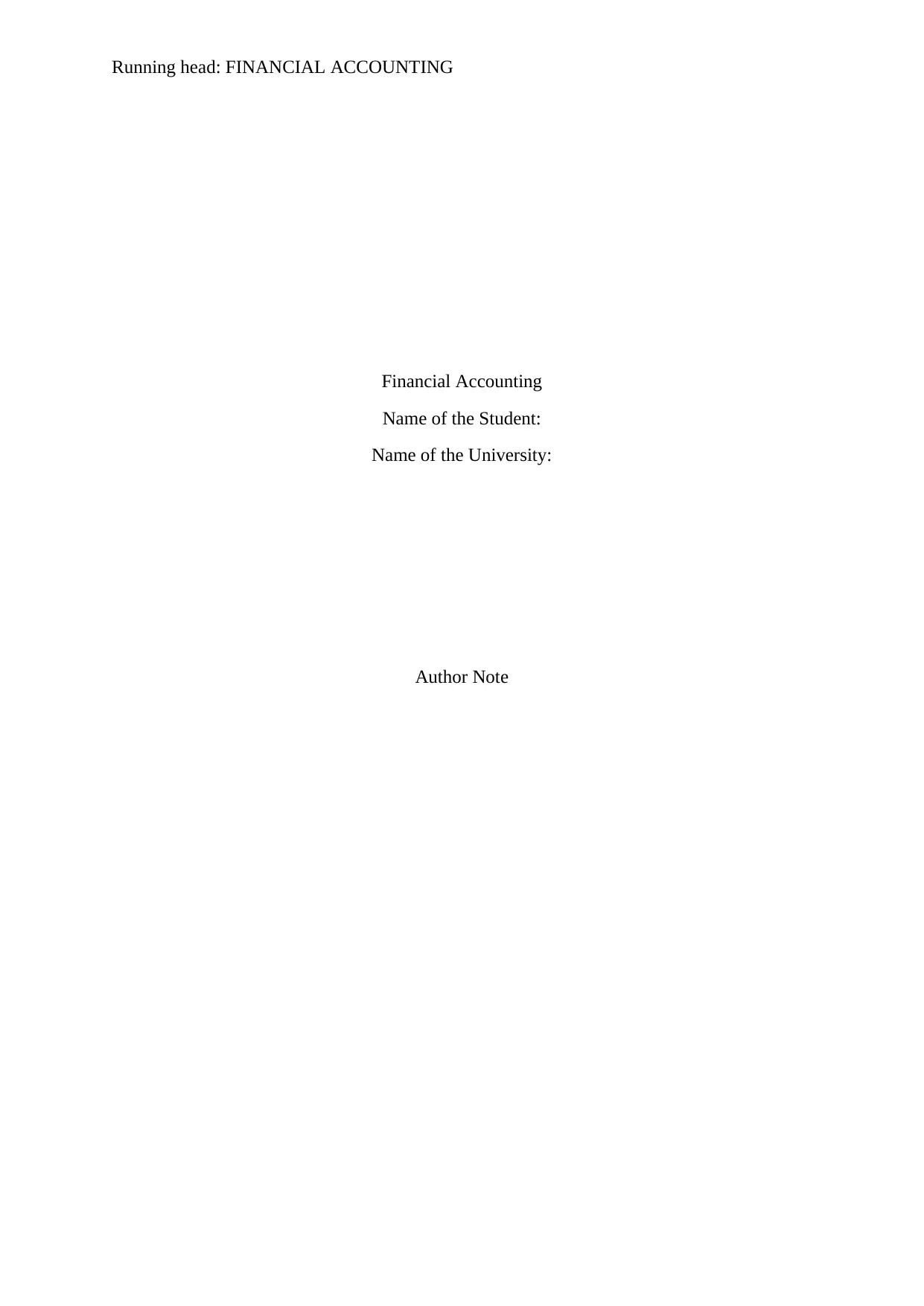
Running head: FINANCIAL ACCOUNTING
Financial Accounting
Name of the Student:
Name of the University:
Author Note
Financial Accounting
Name of the Student:
Name of the University:
Author Note
Paraphrase This Document
Need a fresh take? Get an instant paraphrase of this document with our AI Paraphraser
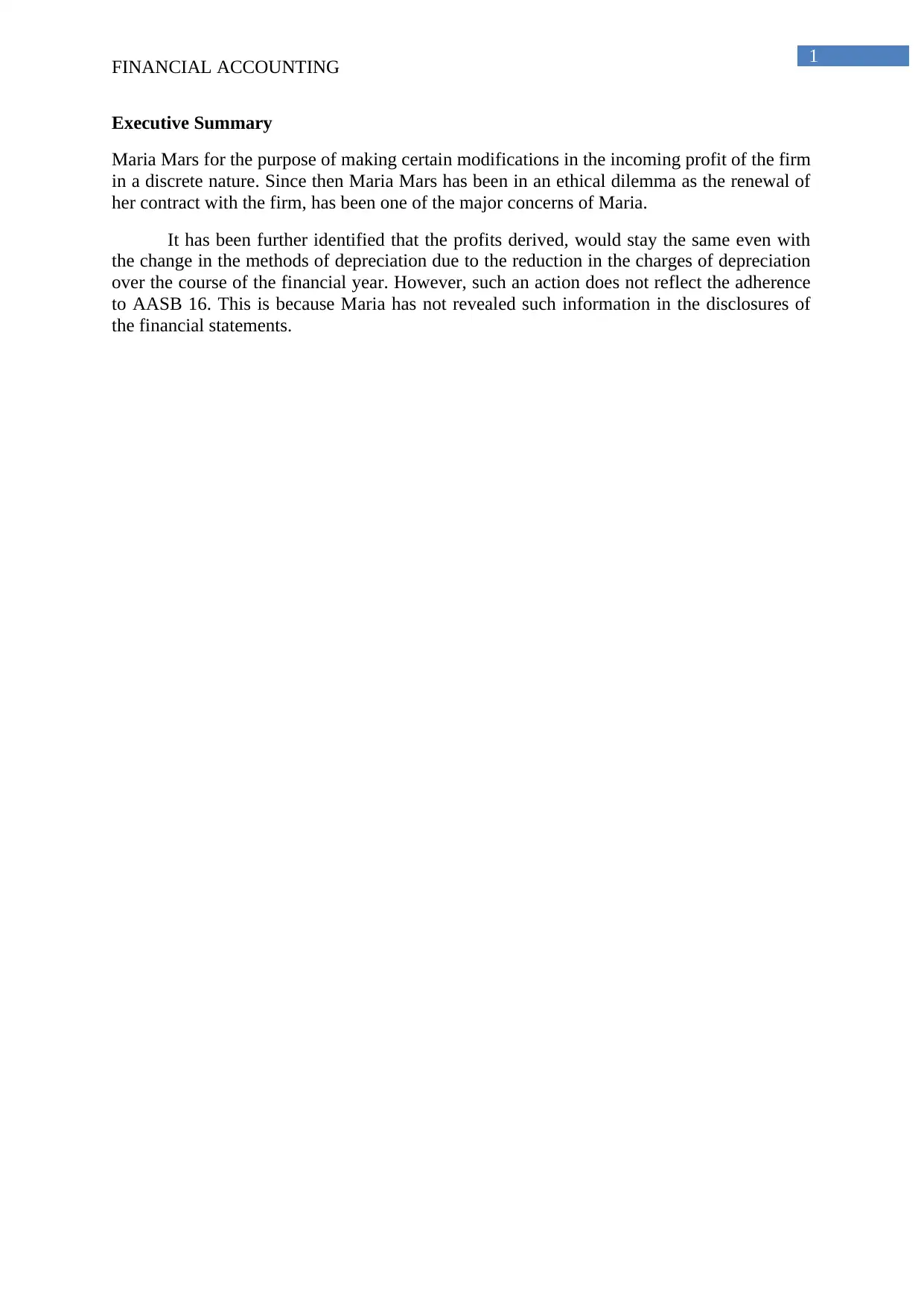
1
FINANCIAL ACCOUNTING
Executive Summary
Maria Mars for the purpose of making certain modifications in the incoming profit of the firm
in a discrete nature. Since then Maria Mars has been in an ethical dilemma as the renewal of
her contract with the firm, has been one of the major concerns of Maria.
It has been further identified that the profits derived, would stay the same even with
the change in the methods of depreciation due to the reduction in the charges of depreciation
over the course of the financial year. However, such an action does not reflect the adherence
to AASB 16. This is because Maria has not revealed such information in the disclosures of
the financial statements.
FINANCIAL ACCOUNTING
Executive Summary
Maria Mars for the purpose of making certain modifications in the incoming profit of the firm
in a discrete nature. Since then Maria Mars has been in an ethical dilemma as the renewal of
her contract with the firm, has been one of the major concerns of Maria.
It has been further identified that the profits derived, would stay the same even with
the change in the methods of depreciation due to the reduction in the charges of depreciation
over the course of the financial year. However, such an action does not reflect the adherence
to AASB 16. This is because Maria has not revealed such information in the disclosures of
the financial statements.
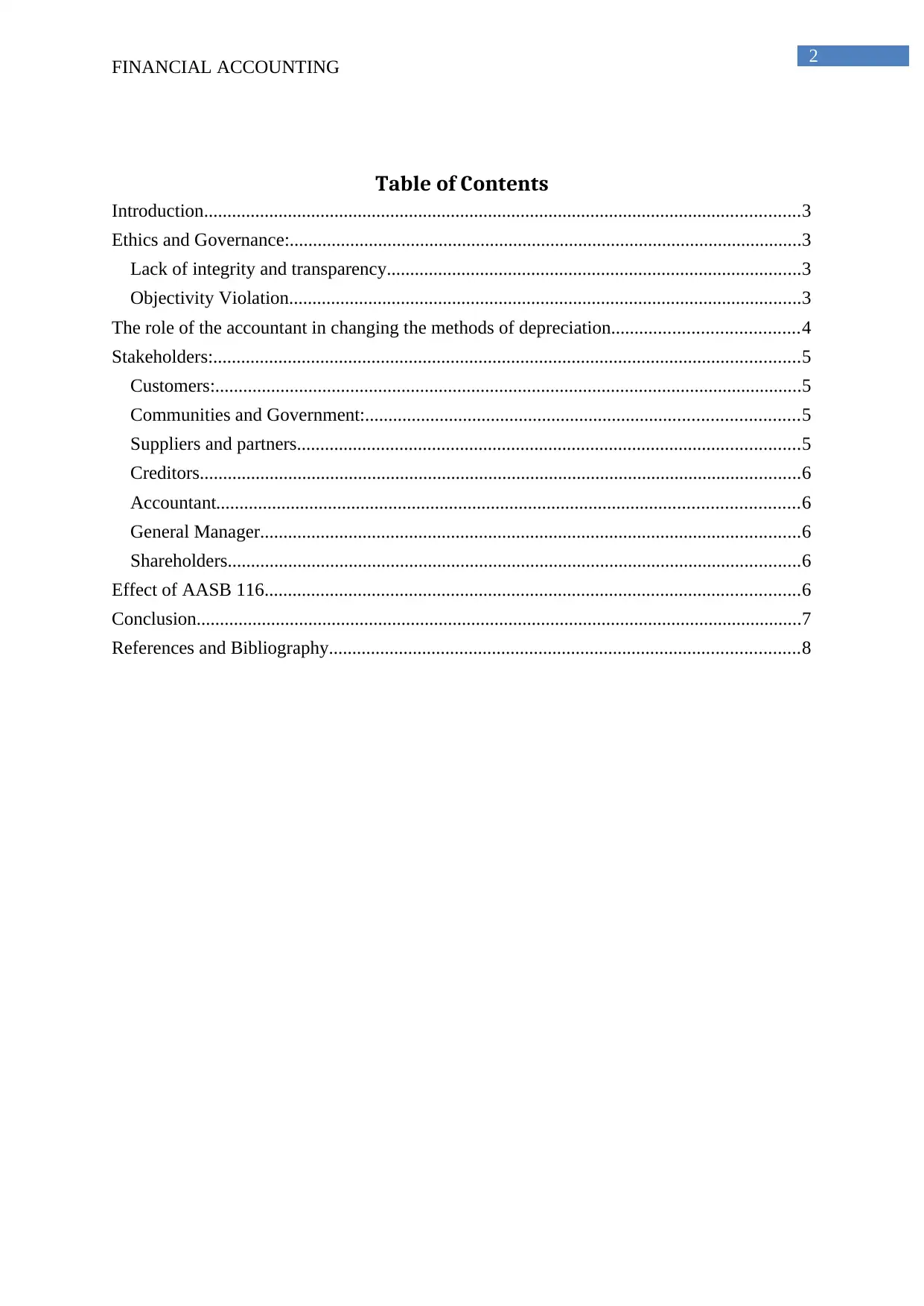
2
FINANCIAL ACCOUNTING
Table of Contents
Introduction................................................................................................................................3
Ethics and Governance:..............................................................................................................3
Lack of integrity and transparency.........................................................................................3
Objectivity Violation..............................................................................................................3
The role of the accountant in changing the methods of depreciation........................................4
Stakeholders:..............................................................................................................................5
Customers:..............................................................................................................................5
Communities and Government:.............................................................................................5
Suppliers and partners............................................................................................................5
Creditors.................................................................................................................................6
Accountant.............................................................................................................................6
General Manager....................................................................................................................6
Shareholders...........................................................................................................................6
Effect of AASB 116...................................................................................................................6
Conclusion..................................................................................................................................7
References and Bibliography.....................................................................................................8
FINANCIAL ACCOUNTING
Table of Contents
Introduction................................................................................................................................3
Ethics and Governance:..............................................................................................................3
Lack of integrity and transparency.........................................................................................3
Objectivity Violation..............................................................................................................3
The role of the accountant in changing the methods of depreciation........................................4
Stakeholders:..............................................................................................................................5
Customers:..............................................................................................................................5
Communities and Government:.............................................................................................5
Suppliers and partners............................................................................................................5
Creditors.................................................................................................................................6
Accountant.............................................................................................................................6
General Manager....................................................................................................................6
Shareholders...........................................................................................................................6
Effect of AASB 116...................................................................................................................6
Conclusion..................................................................................................................................7
References and Bibliography.....................................................................................................8
⊘ This is a preview!⊘
Do you want full access?
Subscribe today to unlock all pages.

Trusted by 1+ million students worldwide
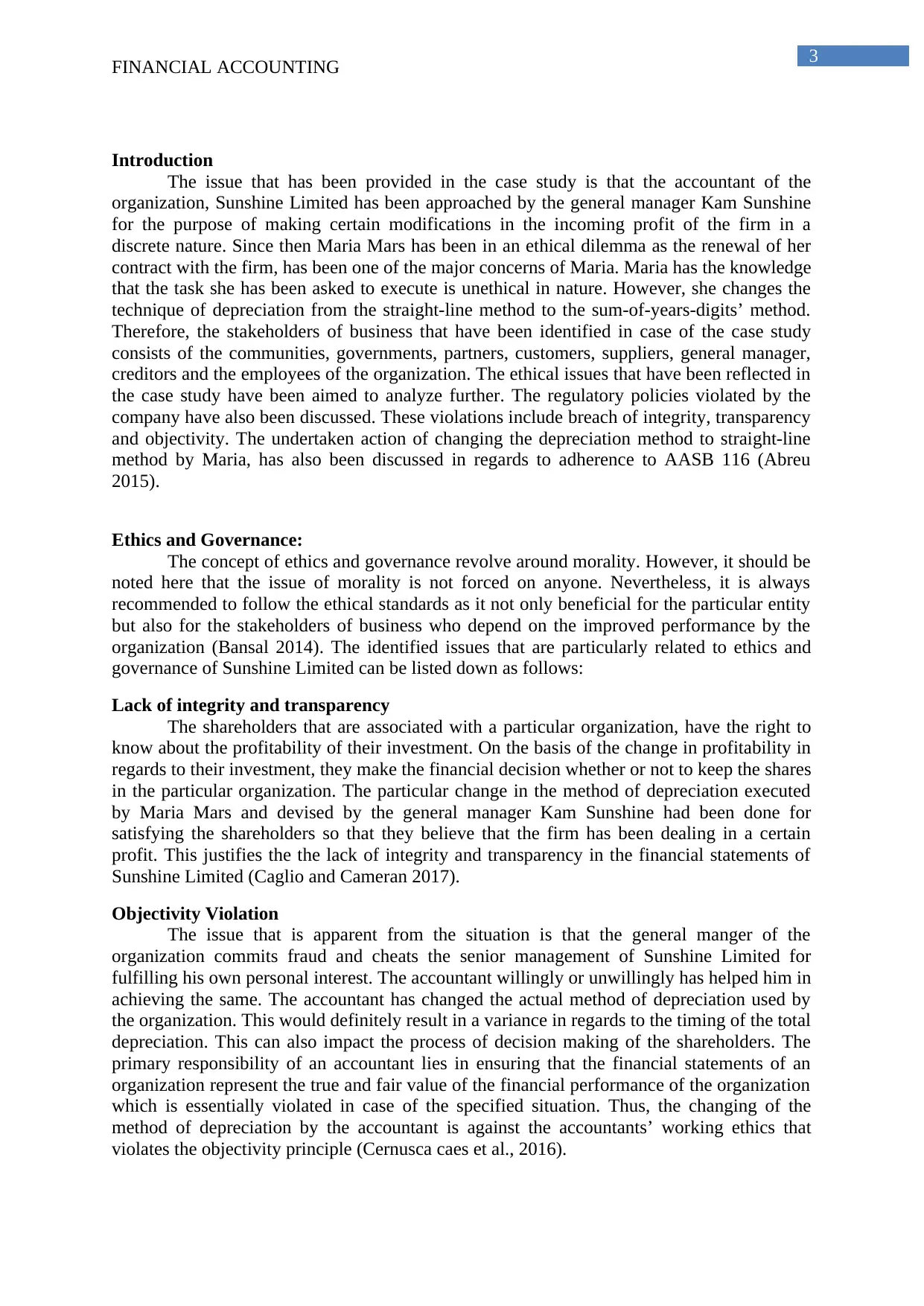
3
FINANCIAL ACCOUNTING
Introduction
The issue that has been provided in the case study is that the accountant of the
organization, Sunshine Limited has been approached by the general manager Kam Sunshine
for the purpose of making certain modifications in the incoming profit of the firm in a
discrete nature. Since then Maria Mars has been in an ethical dilemma as the renewal of her
contract with the firm, has been one of the major concerns of Maria. Maria has the knowledge
that the task she has been asked to execute is unethical in nature. However, she changes the
technique of depreciation from the straight-line method to the sum-of-years-digits’ method.
Therefore, the stakeholders of business that have been identified in case of the case study
consists of the communities, governments, partners, customers, suppliers, general manager,
creditors and the employees of the organization. The ethical issues that have been reflected in
the case study have been aimed to analyze further. The regulatory policies violated by the
company have also been discussed. These violations include breach of integrity, transparency
and objectivity. The undertaken action of changing the depreciation method to straight-line
method by Maria, has also been discussed in regards to adherence to AASB 116 (Abreu
2015).
Ethics and Governance:
The concept of ethics and governance revolve around morality. However, it should be
noted here that the issue of morality is not forced on anyone. Nevertheless, it is always
recommended to follow the ethical standards as it not only beneficial for the particular entity
but also for the stakeholders of business who depend on the improved performance by the
organization (Bansal 2014). The identified issues that are particularly related to ethics and
governance of Sunshine Limited can be listed down as follows:
Lack of integrity and transparency
The shareholders that are associated with a particular organization, have the right to
know about the profitability of their investment. On the basis of the change in profitability in
regards to their investment, they make the financial decision whether or not to keep the shares
in the particular organization. The particular change in the method of depreciation executed
by Maria Mars and devised by the general manager Kam Sunshine had been done for
satisfying the shareholders so that they believe that the firm has been dealing in a certain
profit. This justifies the the lack of integrity and transparency in the financial statements of
Sunshine Limited (Caglio and Cameran 2017).
Objectivity Violation
The issue that is apparent from the situation is that the general manger of the
organization commits fraud and cheats the senior management of Sunshine Limited for
fulfilling his own personal interest. The accountant willingly or unwillingly has helped him in
achieving the same. The accountant has changed the actual method of depreciation used by
the organization. This would definitely result in a variance in regards to the timing of the total
depreciation. This can also impact the process of decision making of the shareholders. The
primary responsibility of an accountant lies in ensuring that the financial statements of an
organization represent the true and fair value of the financial performance of the organization
which is essentially violated in case of the specified situation. Thus, the changing of the
method of depreciation by the accountant is against the accountants’ working ethics that
violates the objectivity principle (Cernusca caes et al., 2016).
FINANCIAL ACCOUNTING
Introduction
The issue that has been provided in the case study is that the accountant of the
organization, Sunshine Limited has been approached by the general manager Kam Sunshine
for the purpose of making certain modifications in the incoming profit of the firm in a
discrete nature. Since then Maria Mars has been in an ethical dilemma as the renewal of her
contract with the firm, has been one of the major concerns of Maria. Maria has the knowledge
that the task she has been asked to execute is unethical in nature. However, she changes the
technique of depreciation from the straight-line method to the sum-of-years-digits’ method.
Therefore, the stakeholders of business that have been identified in case of the case study
consists of the communities, governments, partners, customers, suppliers, general manager,
creditors and the employees of the organization. The ethical issues that have been reflected in
the case study have been aimed to analyze further. The regulatory policies violated by the
company have also been discussed. These violations include breach of integrity, transparency
and objectivity. The undertaken action of changing the depreciation method to straight-line
method by Maria, has also been discussed in regards to adherence to AASB 116 (Abreu
2015).
Ethics and Governance:
The concept of ethics and governance revolve around morality. However, it should be
noted here that the issue of morality is not forced on anyone. Nevertheless, it is always
recommended to follow the ethical standards as it not only beneficial for the particular entity
but also for the stakeholders of business who depend on the improved performance by the
organization (Bansal 2014). The identified issues that are particularly related to ethics and
governance of Sunshine Limited can be listed down as follows:
Lack of integrity and transparency
The shareholders that are associated with a particular organization, have the right to
know about the profitability of their investment. On the basis of the change in profitability in
regards to their investment, they make the financial decision whether or not to keep the shares
in the particular organization. The particular change in the method of depreciation executed
by Maria Mars and devised by the general manager Kam Sunshine had been done for
satisfying the shareholders so that they believe that the firm has been dealing in a certain
profit. This justifies the the lack of integrity and transparency in the financial statements of
Sunshine Limited (Caglio and Cameran 2017).
Objectivity Violation
The issue that is apparent from the situation is that the general manger of the
organization commits fraud and cheats the senior management of Sunshine Limited for
fulfilling his own personal interest. The accountant willingly or unwillingly has helped him in
achieving the same. The accountant has changed the actual method of depreciation used by
the organization. This would definitely result in a variance in regards to the timing of the total
depreciation. This can also impact the process of decision making of the shareholders. The
primary responsibility of an accountant lies in ensuring that the financial statements of an
organization represent the true and fair value of the financial performance of the organization
which is essentially violated in case of the specified situation. Thus, the changing of the
method of depreciation by the accountant is against the accountants’ working ethics that
violates the objectivity principle (Cernusca caes et al., 2016).
Paraphrase This Document
Need a fresh take? Get an instant paraphrase of this document with our AI Paraphraser
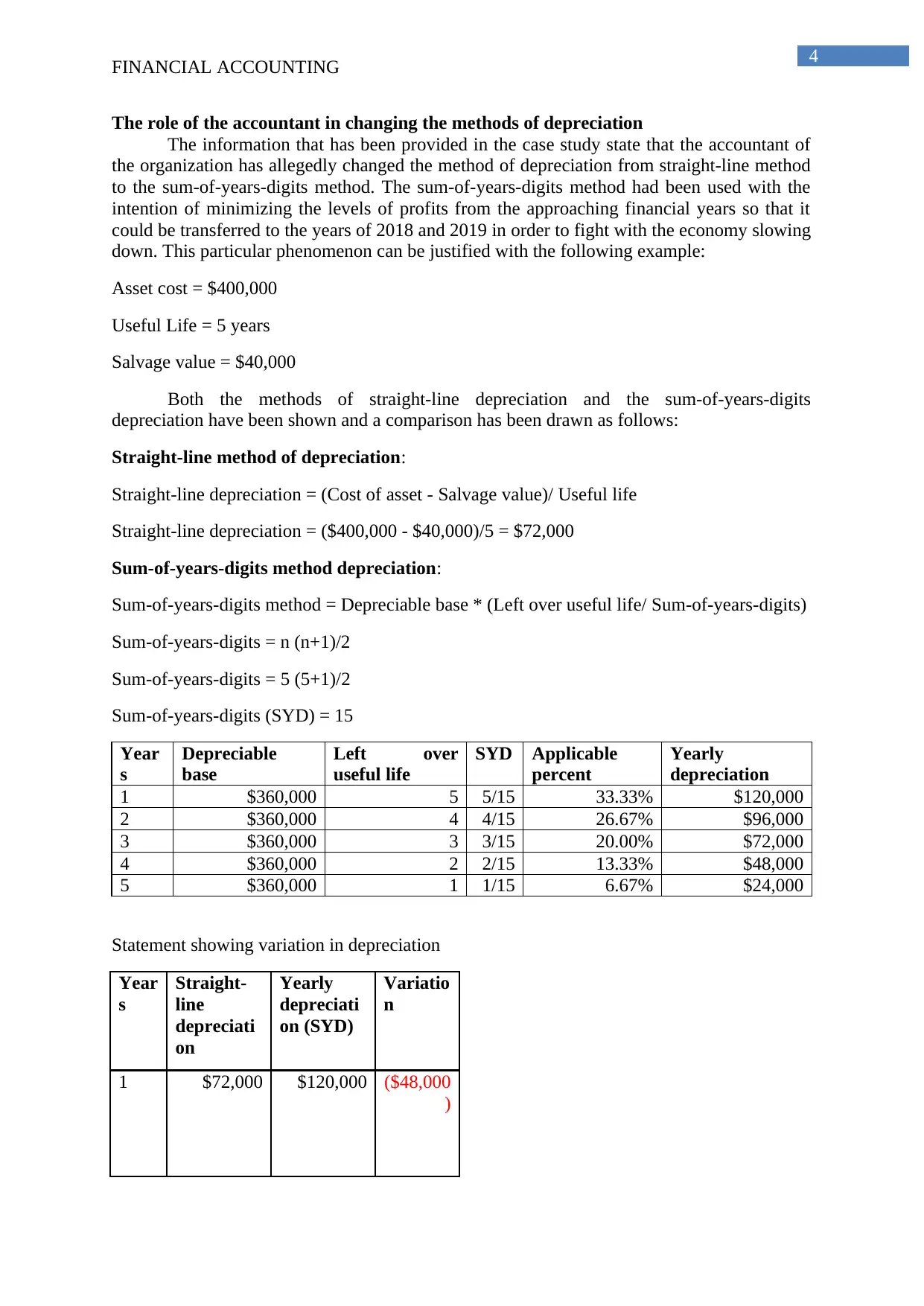
4
FINANCIAL ACCOUNTING
The role of the accountant in changing the methods of depreciation
The information that has been provided in the case study state that the accountant of
the organization has allegedly changed the method of depreciation from straight-line method
to the sum-of-years-digits method. The sum-of-years-digits method had been used with the
intention of minimizing the levels of profits from the approaching financial years so that it
could be transferred to the years of 2018 and 2019 in order to fight with the economy slowing
down. This particular phenomenon can be justified with the following example:
Asset cost = $400,000
Useful Life = 5 years
Salvage value = $40,000
Both the methods of straight-line depreciation and the sum-of-years-digits
depreciation have been shown and a comparison has been drawn as follows:
Straight-line method of depreciation:
Straight-line depreciation = (Cost of asset - Salvage value)/ Useful life
Straight-line depreciation = ($400,000 - $40,000)/5 = $72,000
Sum-of-years-digits method depreciation:
Sum-of-years-digits method = Depreciable base * (Left over useful life/ Sum-of-years-digits)
Sum-of-years-digits = n (n+1)/2
Sum-of-years-digits = 5 (5+1)/2
Sum-of-years-digits (SYD) = 15
Year
s
Depreciable
base
Left over
useful life
SYD Applicable
percent
Yearly
depreciation
1 $360,000 5 5/15 33.33% $120,000
2 $360,000 4 4/15 26.67% $96,000
3 $360,000 3 3/15 20.00% $72,000
4 $360,000 2 2/15 13.33% $48,000
5 $360,000 1 1/15 6.67% $24,000
Statement showing variation in depreciation
Year
s
Straight-
line
depreciati
on
Yearly
depreciati
on (SYD)
Variatio
n
1 $72,000 $120,000 ($48,000
)
FINANCIAL ACCOUNTING
The role of the accountant in changing the methods of depreciation
The information that has been provided in the case study state that the accountant of
the organization has allegedly changed the method of depreciation from straight-line method
to the sum-of-years-digits method. The sum-of-years-digits method had been used with the
intention of minimizing the levels of profits from the approaching financial years so that it
could be transferred to the years of 2018 and 2019 in order to fight with the economy slowing
down. This particular phenomenon can be justified with the following example:
Asset cost = $400,000
Useful Life = 5 years
Salvage value = $40,000
Both the methods of straight-line depreciation and the sum-of-years-digits
depreciation have been shown and a comparison has been drawn as follows:
Straight-line method of depreciation:
Straight-line depreciation = (Cost of asset - Salvage value)/ Useful life
Straight-line depreciation = ($400,000 - $40,000)/5 = $72,000
Sum-of-years-digits method depreciation:
Sum-of-years-digits method = Depreciable base * (Left over useful life/ Sum-of-years-digits)
Sum-of-years-digits = n (n+1)/2
Sum-of-years-digits = 5 (5+1)/2
Sum-of-years-digits (SYD) = 15
Year
s
Depreciable
base
Left over
useful life
SYD Applicable
percent
Yearly
depreciation
1 $360,000 5 5/15 33.33% $120,000
2 $360,000 4 4/15 26.67% $96,000
3 $360,000 3 3/15 20.00% $72,000
4 $360,000 2 2/15 13.33% $48,000
5 $360,000 1 1/15 6.67% $24,000
Statement showing variation in depreciation
Year
s
Straight-
line
depreciati
on
Yearly
depreciati
on (SYD)
Variatio
n
1 $72,000 $120,000 ($48,000
)
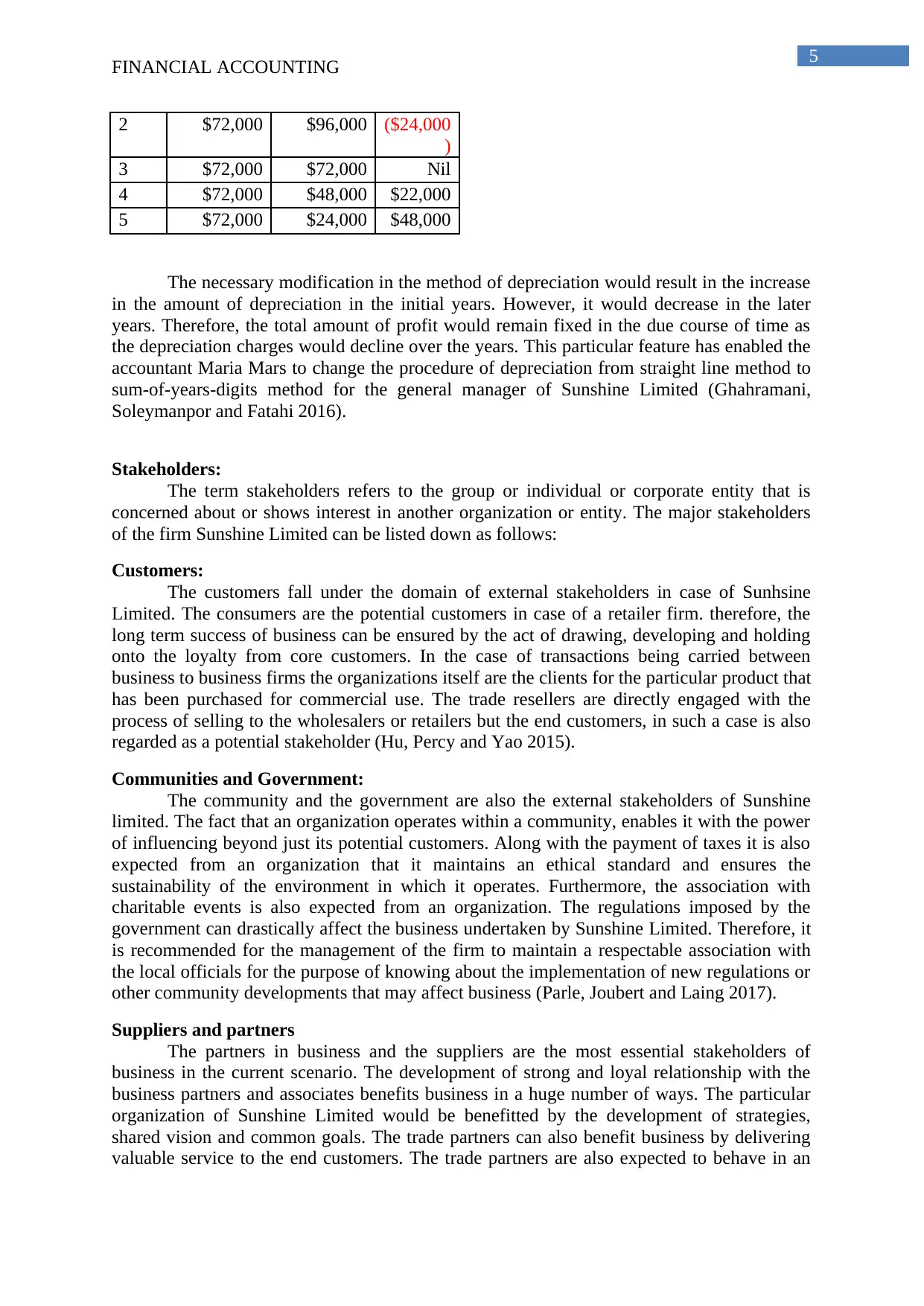
5
FINANCIAL ACCOUNTING
2 $72,000 $96,000 ($24,000
)
3 $72,000 $72,000 Nil
4 $72,000 $48,000 $22,000
5 $72,000 $24,000 $48,000
The necessary modification in the method of depreciation would result in the increase
in the amount of depreciation in the initial years. However, it would decrease in the later
years. Therefore, the total amount of profit would remain fixed in the due course of time as
the depreciation charges would decline over the years. This particular feature has enabled the
accountant Maria Mars to change the procedure of depreciation from straight line method to
sum-of-years-digits method for the general manager of Sunshine Limited (Ghahramani,
Soleymanpor and Fatahi 2016).
Stakeholders:
The term stakeholders refers to the group or individual or corporate entity that is
concerned about or shows interest in another organization or entity. The major stakeholders
of the firm Sunshine Limited can be listed down as follows:
Customers:
The customers fall under the domain of external stakeholders in case of Sunhsine
Limited. The consumers are the potential customers in case of a retailer firm. therefore, the
long term success of business can be ensured by the act of drawing, developing and holding
onto the loyalty from core customers. In the case of transactions being carried between
business to business firms the organizations itself are the clients for the particular product that
has been purchased for commercial use. The trade resellers are directly engaged with the
process of selling to the wholesalers or retailers but the end customers, in such a case is also
regarded as a potential stakeholder (Hu, Percy and Yao 2015).
Communities and Government:
The community and the government are also the external stakeholders of Sunshine
limited. The fact that an organization operates within a community, enables it with the power
of influencing beyond just its potential customers. Along with the payment of taxes it is also
expected from an organization that it maintains an ethical standard and ensures the
sustainability of the environment in which it operates. Furthermore, the association with
charitable events is also expected from an organization. The regulations imposed by the
government can drastically affect the business undertaken by Sunshine Limited. Therefore, it
is recommended for the management of the firm to maintain a respectable association with
the local officials for the purpose of knowing about the implementation of new regulations or
other community developments that may affect business (Parle, Joubert and Laing 2017).
Suppliers and partners
The partners in business and the suppliers are the most essential stakeholders of
business in the current scenario. The development of strong and loyal relationship with the
business partners and associates benefits business in a huge number of ways. The particular
organization of Sunshine Limited would be benefitted by the development of strategies,
shared vision and common goals. The trade partners can also benefit business by delivering
valuable service to the end customers. The trade partners are also expected to behave in an
FINANCIAL ACCOUNTING
2 $72,000 $96,000 ($24,000
)
3 $72,000 $72,000 Nil
4 $72,000 $48,000 $22,000
5 $72,000 $24,000 $48,000
The necessary modification in the method of depreciation would result in the increase
in the amount of depreciation in the initial years. However, it would decrease in the later
years. Therefore, the total amount of profit would remain fixed in the due course of time as
the depreciation charges would decline over the years. This particular feature has enabled the
accountant Maria Mars to change the procedure of depreciation from straight line method to
sum-of-years-digits method for the general manager of Sunshine Limited (Ghahramani,
Soleymanpor and Fatahi 2016).
Stakeholders:
The term stakeholders refers to the group or individual or corporate entity that is
concerned about or shows interest in another organization or entity. The major stakeholders
of the firm Sunshine Limited can be listed down as follows:
Customers:
The customers fall under the domain of external stakeholders in case of Sunhsine
Limited. The consumers are the potential customers in case of a retailer firm. therefore, the
long term success of business can be ensured by the act of drawing, developing and holding
onto the loyalty from core customers. In the case of transactions being carried between
business to business firms the organizations itself are the clients for the particular product that
has been purchased for commercial use. The trade resellers are directly engaged with the
process of selling to the wholesalers or retailers but the end customers, in such a case is also
regarded as a potential stakeholder (Hu, Percy and Yao 2015).
Communities and Government:
The community and the government are also the external stakeholders of Sunshine
limited. The fact that an organization operates within a community, enables it with the power
of influencing beyond just its potential customers. Along with the payment of taxes it is also
expected from an organization that it maintains an ethical standard and ensures the
sustainability of the environment in which it operates. Furthermore, the association with
charitable events is also expected from an organization. The regulations imposed by the
government can drastically affect the business undertaken by Sunshine Limited. Therefore, it
is recommended for the management of the firm to maintain a respectable association with
the local officials for the purpose of knowing about the implementation of new regulations or
other community developments that may affect business (Parle, Joubert and Laing 2017).
Suppliers and partners
The partners in business and the suppliers are the most essential stakeholders of
business in the current scenario. The development of strong and loyal relationship with the
business partners and associates benefits business in a huge number of ways. The particular
organization of Sunshine Limited would be benefitted by the development of strategies,
shared vision and common goals. The trade partners can also benefit business by delivering
valuable service to the end customers. The trade partners are also expected to behave in an
⊘ This is a preview!⊘
Do you want full access?
Subscribe today to unlock all pages.

Trusted by 1+ million students worldwide
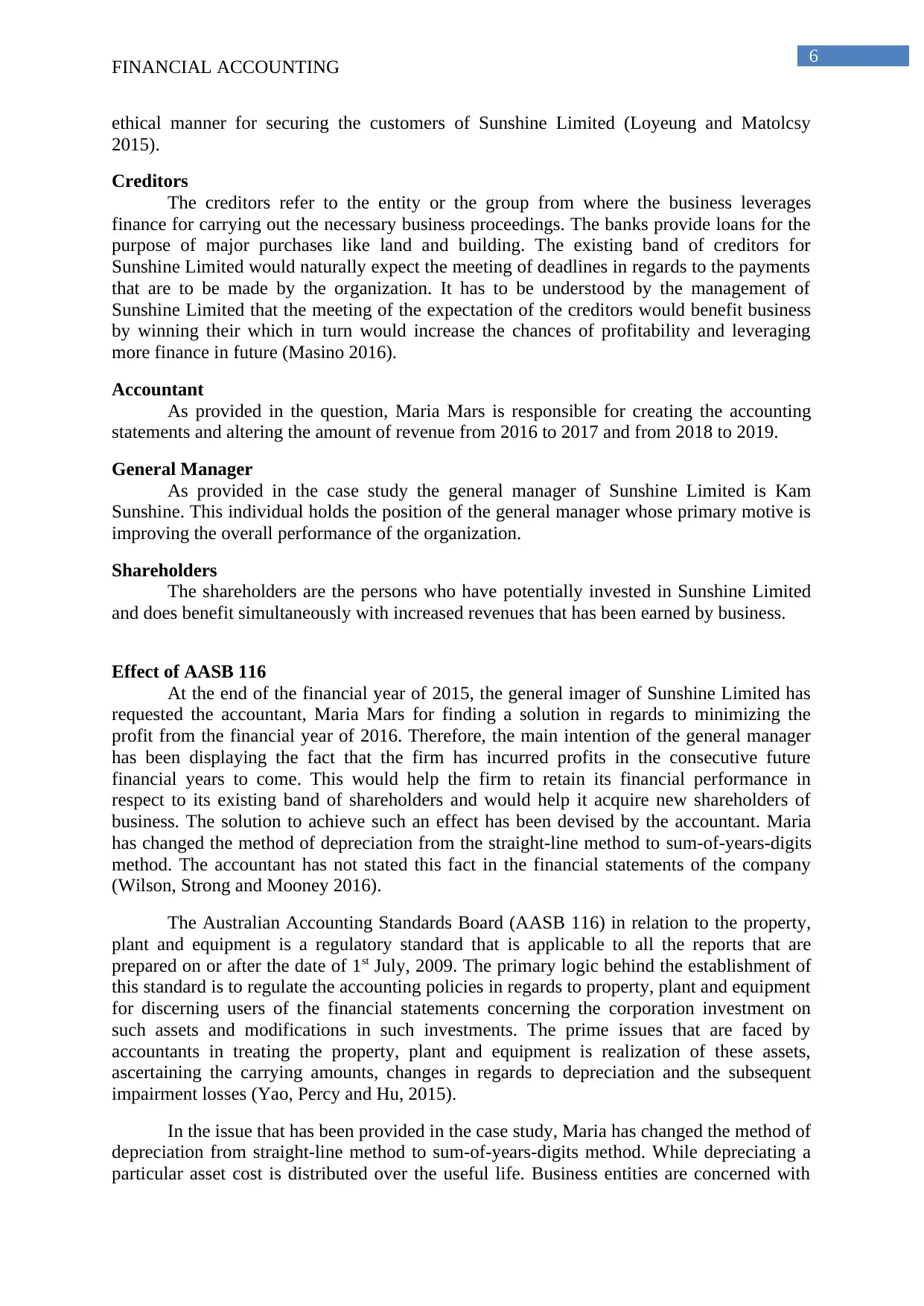
6
FINANCIAL ACCOUNTING
ethical manner for securing the customers of Sunshine Limited (Loyeung and Matolcsy
2015).
Creditors
The creditors refer to the entity or the group from where the business leverages
finance for carrying out the necessary business proceedings. The banks provide loans for the
purpose of major purchases like land and building. The existing band of creditors for
Sunshine Limited would naturally expect the meeting of deadlines in regards to the payments
that are to be made by the organization. It has to be understood by the management of
Sunshine Limited that the meeting of the expectation of the creditors would benefit business
by winning their which in turn would increase the chances of profitability and leveraging
more finance in future (Masino 2016).
Accountant
As provided in the question, Maria Mars is responsible for creating the accounting
statements and altering the amount of revenue from 2016 to 2017 and from 2018 to 2019.
General Manager
As provided in the case study the general manager of Sunshine Limited is Kam
Sunshine. This individual holds the position of the general manager whose primary motive is
improving the overall performance of the organization.
Shareholders
The shareholders are the persons who have potentially invested in Sunshine Limited
and does benefit simultaneously with increased revenues that has been earned by business.
Effect of AASB 116
At the end of the financial year of 2015, the general imager of Sunshine Limited has
requested the accountant, Maria Mars for finding a solution in regards to minimizing the
profit from the financial year of 2016. Therefore, the main intention of the general manager
has been displaying the fact that the firm has incurred profits in the consecutive future
financial years to come. This would help the firm to retain its financial performance in
respect to its existing band of shareholders and would help it acquire new shareholders of
business. The solution to achieve such an effect has been devised by the accountant. Maria
has changed the method of depreciation from the straight-line method to sum-of-years-digits
method. The accountant has not stated this fact in the financial statements of the company
(Wilson, Strong and Mooney 2016).
The Australian Accounting Standards Board (AASB 116) in relation to the property,
plant and equipment is a regulatory standard that is applicable to all the reports that are
prepared on or after the date of 1st July, 2009. The primary logic behind the establishment of
this standard is to regulate the accounting policies in regards to property, plant and equipment
for discerning users of the financial statements concerning the corporation investment on
such assets and modifications in such investments. The prime issues that are faced by
accountants in treating the property, plant and equipment is realization of these assets,
ascertaining the carrying amounts, changes in regards to depreciation and the subsequent
impairment losses (Yao, Percy and Hu, 2015).
In the issue that has been provided in the case study, Maria has changed the method of
depreciation from straight-line method to sum-of-years-digits method. While depreciating a
particular asset cost is distributed over the useful life. Business entities are concerned with
FINANCIAL ACCOUNTING
ethical manner for securing the customers of Sunshine Limited (Loyeung and Matolcsy
2015).
Creditors
The creditors refer to the entity or the group from where the business leverages
finance for carrying out the necessary business proceedings. The banks provide loans for the
purpose of major purchases like land and building. The existing band of creditors for
Sunshine Limited would naturally expect the meeting of deadlines in regards to the payments
that are to be made by the organization. It has to be understood by the management of
Sunshine Limited that the meeting of the expectation of the creditors would benefit business
by winning their which in turn would increase the chances of profitability and leveraging
more finance in future (Masino 2016).
Accountant
As provided in the question, Maria Mars is responsible for creating the accounting
statements and altering the amount of revenue from 2016 to 2017 and from 2018 to 2019.
General Manager
As provided in the case study the general manager of Sunshine Limited is Kam
Sunshine. This individual holds the position of the general manager whose primary motive is
improving the overall performance of the organization.
Shareholders
The shareholders are the persons who have potentially invested in Sunshine Limited
and does benefit simultaneously with increased revenues that has been earned by business.
Effect of AASB 116
At the end of the financial year of 2015, the general imager of Sunshine Limited has
requested the accountant, Maria Mars for finding a solution in regards to minimizing the
profit from the financial year of 2016. Therefore, the main intention of the general manager
has been displaying the fact that the firm has incurred profits in the consecutive future
financial years to come. This would help the firm to retain its financial performance in
respect to its existing band of shareholders and would help it acquire new shareholders of
business. The solution to achieve such an effect has been devised by the accountant. Maria
has changed the method of depreciation from the straight-line method to sum-of-years-digits
method. The accountant has not stated this fact in the financial statements of the company
(Wilson, Strong and Mooney 2016).
The Australian Accounting Standards Board (AASB 116) in relation to the property,
plant and equipment is a regulatory standard that is applicable to all the reports that are
prepared on or after the date of 1st July, 2009. The primary logic behind the establishment of
this standard is to regulate the accounting policies in regards to property, plant and equipment
for discerning users of the financial statements concerning the corporation investment on
such assets and modifications in such investments. The prime issues that are faced by
accountants in treating the property, plant and equipment is realization of these assets,
ascertaining the carrying amounts, changes in regards to depreciation and the subsequent
impairment losses (Yao, Percy and Hu, 2015).
In the issue that has been provided in the case study, Maria has changed the method of
depreciation from straight-line method to sum-of-years-digits method. While depreciating a
particular asset cost is distributed over the useful life. Business entities are concerned with
Paraphrase This Document
Need a fresh take? Get an instant paraphrase of this document with our AI Paraphraser
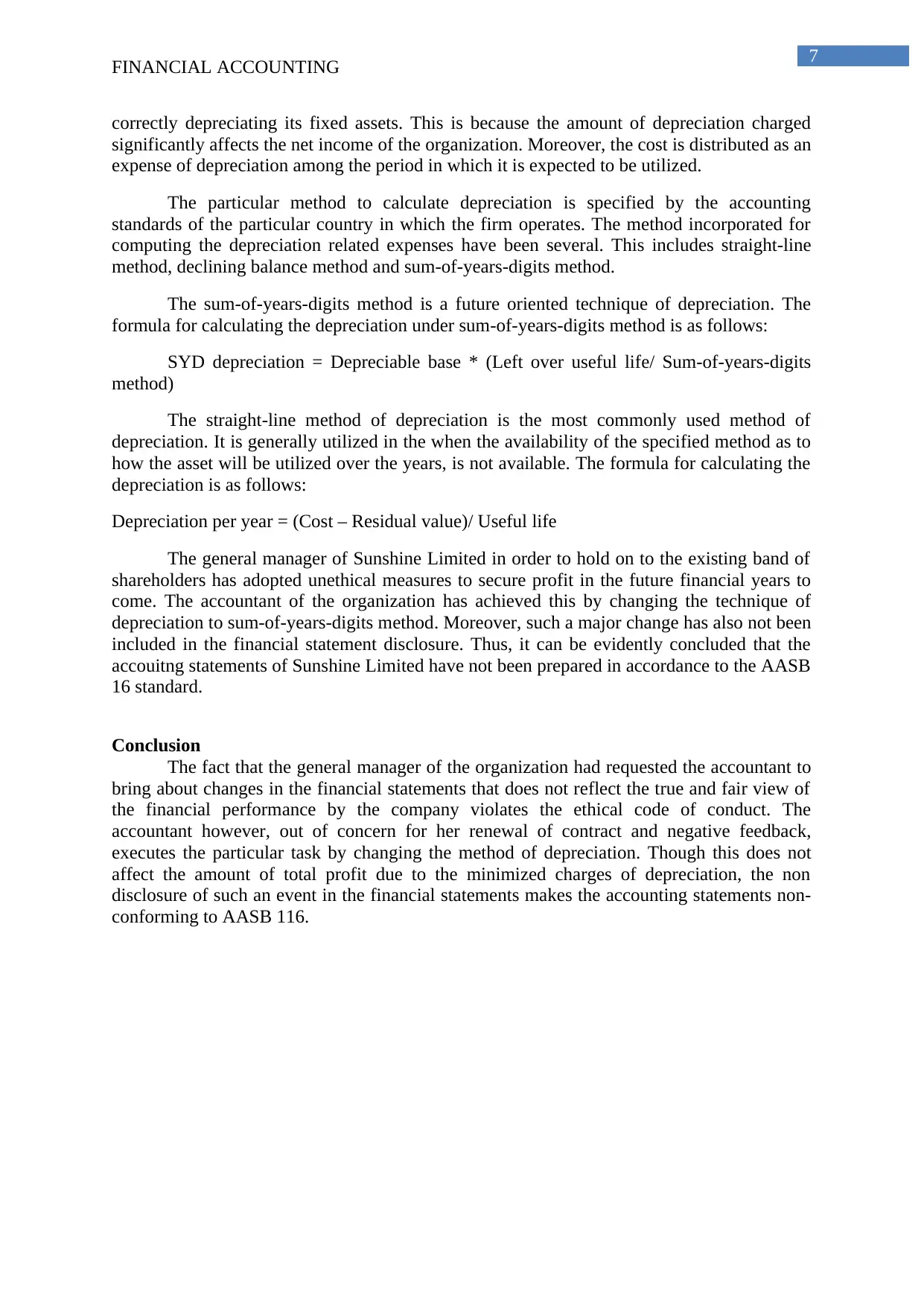
7
FINANCIAL ACCOUNTING
correctly depreciating its fixed assets. This is because the amount of depreciation charged
significantly affects the net income of the organization. Moreover, the cost is distributed as an
expense of depreciation among the period in which it is expected to be utilized.
The particular method to calculate depreciation is specified by the accounting
standards of the particular country in which the firm operates. The method incorporated for
computing the depreciation related expenses have been several. This includes straight-line
method, declining balance method and sum-of-years-digits method.
The sum-of-years-digits method is a future oriented technique of depreciation. The
formula for calculating the depreciation under sum-of-years-digits method is as follows:
SYD depreciation = Depreciable base * (Left over useful life/ Sum-of-years-digits
method)
The straight-line method of depreciation is the most commonly used method of
depreciation. It is generally utilized in the when the availability of the specified method as to
how the asset will be utilized over the years, is not available. The formula for calculating the
depreciation is as follows:
Depreciation per year = (Cost – Residual value)/ Useful life
The general manager of Sunshine Limited in order to hold on to the existing band of
shareholders has adopted unethical measures to secure profit in the future financial years to
come. The accountant of the organization has achieved this by changing the technique of
depreciation to sum-of-years-digits method. Moreover, such a major change has also not been
included in the financial statement disclosure. Thus, it can be evidently concluded that the
accouitng statements of Sunshine Limited have not been prepared in accordance to the AASB
16 standard.
Conclusion
The fact that the general manager of the organization had requested the accountant to
bring about changes in the financial statements that does not reflect the true and fair view of
the financial performance by the company violates the ethical code of conduct. The
accountant however, out of concern for her renewal of contract and negative feedback,
executes the particular task by changing the method of depreciation. Though this does not
affect the amount of total profit due to the minimized charges of depreciation, the non
disclosure of such an event in the financial statements makes the accounting statements non-
conforming to AASB 116.
FINANCIAL ACCOUNTING
correctly depreciating its fixed assets. This is because the amount of depreciation charged
significantly affects the net income of the organization. Moreover, the cost is distributed as an
expense of depreciation among the period in which it is expected to be utilized.
The particular method to calculate depreciation is specified by the accounting
standards of the particular country in which the firm operates. The method incorporated for
computing the depreciation related expenses have been several. This includes straight-line
method, declining balance method and sum-of-years-digits method.
The sum-of-years-digits method is a future oriented technique of depreciation. The
formula for calculating the depreciation under sum-of-years-digits method is as follows:
SYD depreciation = Depreciable base * (Left over useful life/ Sum-of-years-digits
method)
The straight-line method of depreciation is the most commonly used method of
depreciation. It is generally utilized in the when the availability of the specified method as to
how the asset will be utilized over the years, is not available. The formula for calculating the
depreciation is as follows:
Depreciation per year = (Cost – Residual value)/ Useful life
The general manager of Sunshine Limited in order to hold on to the existing band of
shareholders has adopted unethical measures to secure profit in the future financial years to
come. The accountant of the organization has achieved this by changing the technique of
depreciation to sum-of-years-digits method. Moreover, such a major change has also not been
included in the financial statement disclosure. Thus, it can be evidently concluded that the
accouitng statements of Sunshine Limited have not been prepared in accordance to the AASB
16 standard.
Conclusion
The fact that the general manager of the organization had requested the accountant to
bring about changes in the financial statements that does not reflect the true and fair view of
the financial performance by the company violates the ethical code of conduct. The
accountant however, out of concern for her renewal of contract and negative feedback,
executes the particular task by changing the method of depreciation. Though this does not
affect the amount of total profit due to the minimized charges of depreciation, the non
disclosure of such an event in the financial statements makes the accounting statements non-
conforming to AASB 116.
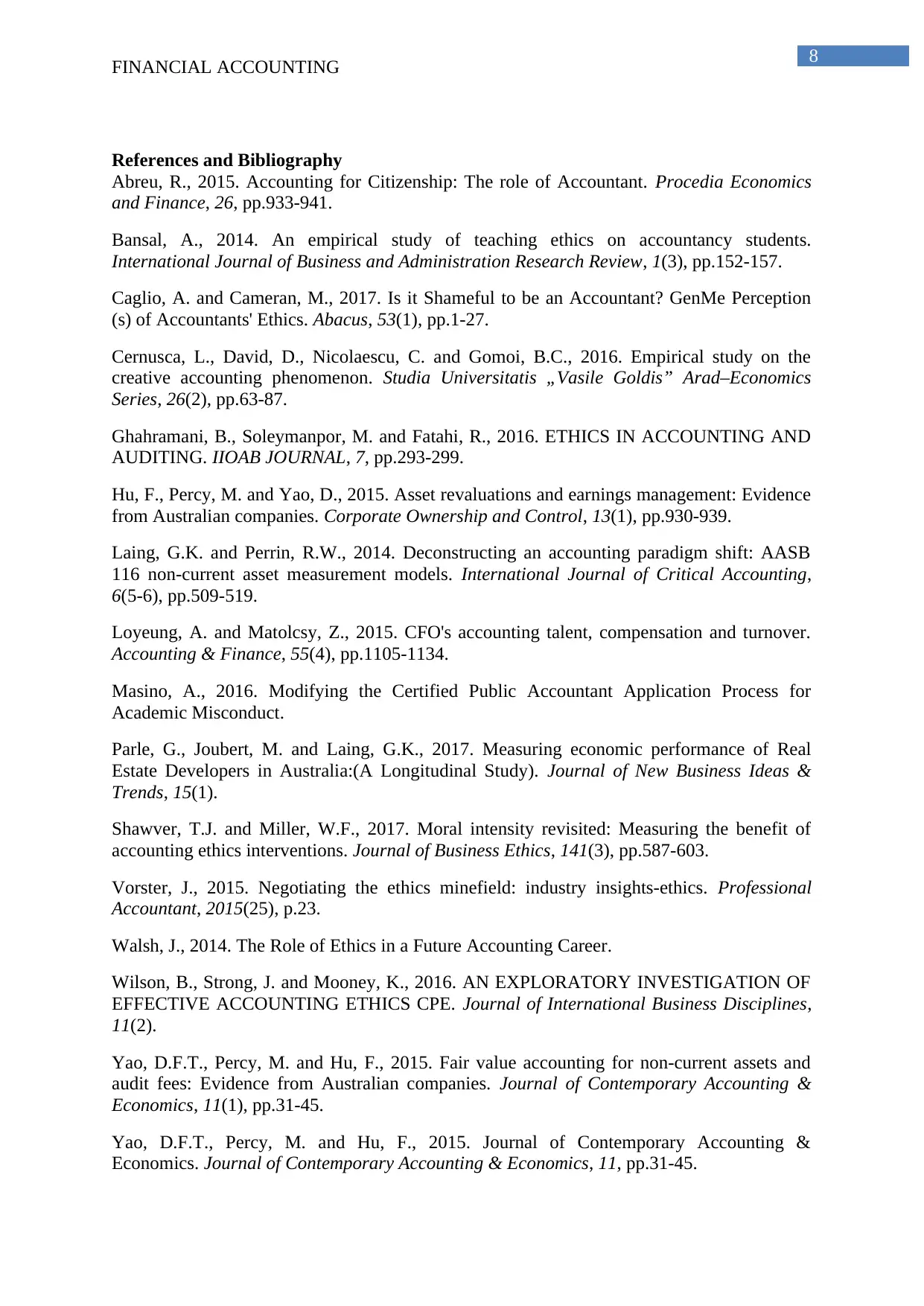
8
FINANCIAL ACCOUNTING
References and Bibliography
Abreu, R., 2015. Accounting for Citizenship: The role of Accountant. Procedia Economics
and Finance, 26, pp.933-941.
Bansal, A., 2014. An empirical study of teaching ethics on accountancy students.
International Journal of Business and Administration Research Review, 1(3), pp.152-157.
Caglio, A. and Cameran, M., 2017. Is it Shameful to be an Accountant? GenMe Perception
(s) of Accountants' Ethics. Abacus, 53(1), pp.1-27.
Cernusca, L., David, D., Nicolaescu, C. and Gomoi, B.C., 2016. Empirical study on the
creative accounting phenomenon. Studia Universitatis „Vasile Goldis” Arad–Economics
Series, 26(2), pp.63-87.
Ghahramani, B., Soleymanpor, M. and Fatahi, R., 2016. ETHICS IN ACCOUNTING AND
AUDITING. IIOAB JOURNAL, 7, pp.293-299.
Hu, F., Percy, M. and Yao, D., 2015. Asset revaluations and earnings management: Evidence
from Australian companies. Corporate Ownership and Control, 13(1), pp.930-939.
Laing, G.K. and Perrin, R.W., 2014. Deconstructing an accounting paradigm shift: AASB
116 non-current asset measurement models. International Journal of Critical Accounting,
6(5-6), pp.509-519.
Loyeung, A. and Matolcsy, Z., 2015. CFO's accounting talent, compensation and turnover.
Accounting & Finance, 55(4), pp.1105-1134.
Masino, A., 2016. Modifying the Certified Public Accountant Application Process for
Academic Misconduct.
Parle, G., Joubert, M. and Laing, G.K., 2017. Measuring economic performance of Real
Estate Developers in Australia:(A Longitudinal Study). Journal of New Business Ideas &
Trends, 15(1).
Shawver, T.J. and Miller, W.F., 2017. Moral intensity revisited: Measuring the benefit of
accounting ethics interventions. Journal of Business Ethics, 141(3), pp.587-603.
Vorster, J., 2015. Negotiating the ethics minefield: industry insights-ethics. Professional
Accountant, 2015(25), p.23.
Walsh, J., 2014. The Role of Ethics in a Future Accounting Career.
Wilson, B., Strong, J. and Mooney, K., 2016. AN EXPLORATORY INVESTIGATION OF
EFFECTIVE ACCOUNTING ETHICS CPE. Journal of International Business Disciplines,
11(2).
Yao, D.F.T., Percy, M. and Hu, F., 2015. Fair value accounting for non-current assets and
audit fees: Evidence from Australian companies. Journal of Contemporary Accounting &
Economics, 11(1), pp.31-45.
Yao, D.F.T., Percy, M. and Hu, F., 2015. Journal of Contemporary Accounting &
Economics. Journal of Contemporary Accounting & Economics, 11, pp.31-45.
FINANCIAL ACCOUNTING
References and Bibliography
Abreu, R., 2015. Accounting for Citizenship: The role of Accountant. Procedia Economics
and Finance, 26, pp.933-941.
Bansal, A., 2014. An empirical study of teaching ethics on accountancy students.
International Journal of Business and Administration Research Review, 1(3), pp.152-157.
Caglio, A. and Cameran, M., 2017. Is it Shameful to be an Accountant? GenMe Perception
(s) of Accountants' Ethics. Abacus, 53(1), pp.1-27.
Cernusca, L., David, D., Nicolaescu, C. and Gomoi, B.C., 2016. Empirical study on the
creative accounting phenomenon. Studia Universitatis „Vasile Goldis” Arad–Economics
Series, 26(2), pp.63-87.
Ghahramani, B., Soleymanpor, M. and Fatahi, R., 2016. ETHICS IN ACCOUNTING AND
AUDITING. IIOAB JOURNAL, 7, pp.293-299.
Hu, F., Percy, M. and Yao, D., 2015. Asset revaluations and earnings management: Evidence
from Australian companies. Corporate Ownership and Control, 13(1), pp.930-939.
Laing, G.K. and Perrin, R.W., 2014. Deconstructing an accounting paradigm shift: AASB
116 non-current asset measurement models. International Journal of Critical Accounting,
6(5-6), pp.509-519.
Loyeung, A. and Matolcsy, Z., 2015. CFO's accounting talent, compensation and turnover.
Accounting & Finance, 55(4), pp.1105-1134.
Masino, A., 2016. Modifying the Certified Public Accountant Application Process for
Academic Misconduct.
Parle, G., Joubert, M. and Laing, G.K., 2017. Measuring economic performance of Real
Estate Developers in Australia:(A Longitudinal Study). Journal of New Business Ideas &
Trends, 15(1).
Shawver, T.J. and Miller, W.F., 2017. Moral intensity revisited: Measuring the benefit of
accounting ethics interventions. Journal of Business Ethics, 141(3), pp.587-603.
Vorster, J., 2015. Negotiating the ethics minefield: industry insights-ethics. Professional
Accountant, 2015(25), p.23.
Walsh, J., 2014. The Role of Ethics in a Future Accounting Career.
Wilson, B., Strong, J. and Mooney, K., 2016. AN EXPLORATORY INVESTIGATION OF
EFFECTIVE ACCOUNTING ETHICS CPE. Journal of International Business Disciplines,
11(2).
Yao, D.F.T., Percy, M. and Hu, F., 2015. Fair value accounting for non-current assets and
audit fees: Evidence from Australian companies. Journal of Contemporary Accounting &
Economics, 11(1), pp.31-45.
Yao, D.F.T., Percy, M. and Hu, F., 2015. Journal of Contemporary Accounting &
Economics. Journal of Contemporary Accounting & Economics, 11, pp.31-45.
⊘ This is a preview!⊘
Do you want full access?
Subscribe today to unlock all pages.

Trusted by 1+ million students worldwide
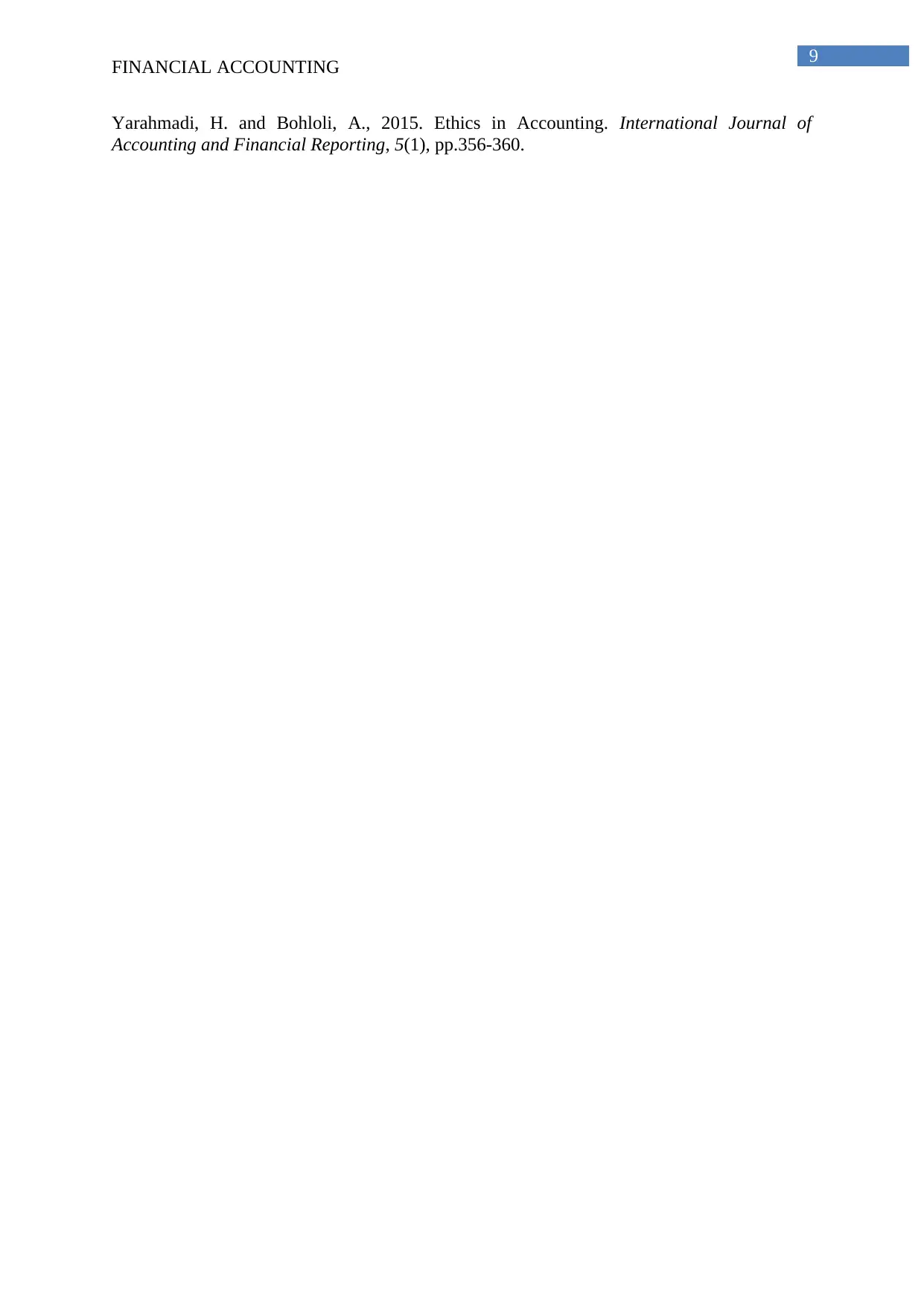
9
FINANCIAL ACCOUNTING
Yarahmadi, H. and Bohloli, A., 2015. Ethics in Accounting. International Journal of
Accounting and Financial Reporting, 5(1), pp.356-360.
FINANCIAL ACCOUNTING
Yarahmadi, H. and Bohloli, A., 2015. Ethics in Accounting. International Journal of
Accounting and Financial Reporting, 5(1), pp.356-360.
1 out of 10
Related Documents
Your All-in-One AI-Powered Toolkit for Academic Success.
+13062052269
info@desklib.com
Available 24*7 on WhatsApp / Email
![[object Object]](/_next/static/media/star-bottom.7253800d.svg)
Unlock your academic potential
Copyright © 2020–2025 A2Z Services. All Rights Reserved. Developed and managed by ZUCOL.





